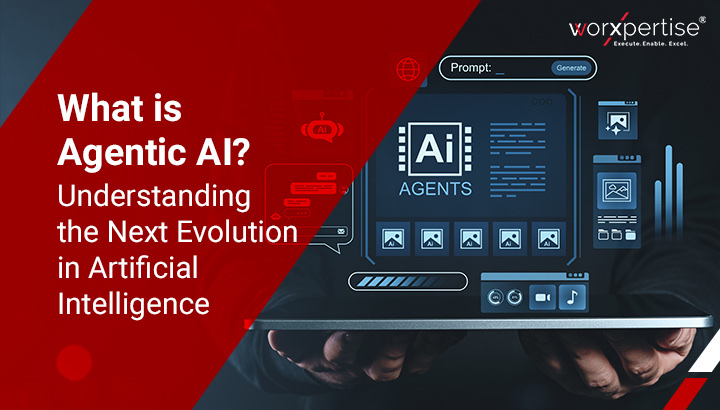
Not long ago, Artificial Intelligence was seen as a far-off idea. Today, it’s part of everyday business life. We have chatbots answering our queries, algorithms suggesting what we might buy next, and voice assistants helping us set reminders. Most of this is powered by Generative AI systems that can create content, draft responses, or analyze data based on our prompts.
But there’s a new wave of AI emerging that goes beyond responding. It’s called Agentic AI, and it’s changing how work gets done. Instead of just producing an output, Agentic AI can make decisions, plan actions, and carry them out without constant human input. Think of traditional AI as a calculator, it gives answers, but you have to tell it exactly what to do every time. Agentic AI, on the other hand, is more like a capable assistant who can manage a project end-to-end. It understands the big picture, adapts to changing situations, and moves things forward without needing constant input.
In this blog, we’ll break down what Agentic AI is, how it’s different from Generative AI, and why companies are already seeing strong results from it.
Generative AI, like ChatGPT or image creators, works best when you give it a clear prompt. It responds with text, images, or analysis, but the action stops there. The decision-making power remains with the human user.
Agentic AI, on the other hand, is designed to operate more like an independent helper. Once you set the goal, it figures out the steps, executes them, and adapts if conditions change.
For example, a generative AI can write an email draft for a customer inquiry. An agentic AI can read the inquiry, check customer records, draft the reply, send it, and log the interaction in the CRM without you needing to manage every step.
Many companies have experimented with Generative AI tools, but adoption hasn’t always led to measurable change. McKinsey calls this the “Gen AI paradox”, businesses are generating ideas faster yet still relying heavily on human teams to execute them.
Agentic AI helps close this gap by not just suggesting actions but actually carrying them out. According to PwC’s 2024 AI Agents Survey, 73% of business leaders believe AI agents will give them a competitive advantage, and 75% are confident in their AI adoption strategy. This confidence comes from early results: faster turnaround times, fewer manual tasks, and lower operational costs.
CFOs are also taking notice. Research from ITPro found that organizations expect up to 20% cost savings and significant revenue growth when they integrate AI agents into workflows. The message is clear: Agentic AI is not just a tech upgrade; it’s a business growth engine.
Agentic AI isn’t just an experimental concept. Modern businesses are already putting it to work, and the results are hard to ignore.
Take Siemens, a global leader in industrial automation. They use AI agents to monitor machinery, predict maintenance needs, and schedule repairs automatically. This proactive approach has reduced unplanned downtime by nearly 25%, saving millions annually in lost productivity.
In the retail space, H&M introduced a virtual shopping assistant built with Agentic AI. It doesn’t just answer product questions it checks stock, suggests outfits, and completes purchases. As a result, customer queries are resolved 70% faster, conversions are up by 25%, and customer satisfaction scores have improved.
Cybersecurity company Darktrace uses autonomous AI agents to scan for unusual network activity and respond instantly to threats. In some cases, the system has neutralized over 90% of threats in milliseconds, far faster than a human security team could react.
In healthcare, Mass General Brigham deployed an AI documentation assistant that listens to doctor-patient conversations, updates medical records, and files insurance paperwork in the background. This has cut doctors’ administrative time by 60%, allowing them to focus on patient care.
Even in customer service, Agentic AI is proving its worth. Salesforce’s Agent force now handles 84% of routine queries without human help, freeing agents for complex cases and improving resolution times dramatically.
From manufacturing floors to hospital rooms, these examples show that Agentic AI can adapt to different industries and deliver tangible business outcomes.
At its core, Agentic AI learns what you want done and works through the steps without you needing to hold its hand. If Generative AI is like a friendly note-taker, Agentic AI is the coworker who takes the notes, sends the follow-up emails, and gets the project moving.
McKinsey calls this connected approach the “agentic AI mesh”. Multiple AI agents working together across different systems. For example, one agent might monitor inventory, another handle orders, and a third manage customer updates. The real magic happens when they share information automatically, making decisions in sync without constant human involvement.
But technology alone isn’t enough. Trust plays a big role in adoption. A Workday study found 75% of people see AI agents as teammates, yet only 24% trust them to work without supervision. That means companies need to roll out Agentic AI carefully, showing that it can be accurate, ethical, and transparent before asking employees or customers to rely on it fully.
Companies that approach Agentic AI this way build trust faster and get results sooner.
Agentic AI is more than just a smarter chatbot, it’s a capable teammate that can think ahead, take action, and coordinate across systems. The businesses already using it are seeing faster processes, lower costs, and happier customers. With proven ROI and adoption growing across industries, this is no longer a “future tech” conversation.
In the next blog of our series, we’ll look under the hood at how Agentic AI actually works the architecture, planning, and integrations that turn these autonomous agents from ideas into action.
Author: Pooja Sharma